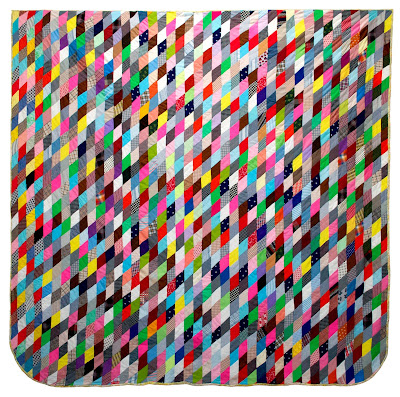 |
| Rudimentary understanding of quilts suggests their sole purpose is to exist as bedding. |
 |
| "Arrangement in Grey and Black No. 1" by James McNeill Whistler |
 |
| 2018 Spring Quilt Market, Portland |
 |
| quilts may represent a "nice, little hobby" but they are also worthy of serious academic study |
Certainly, a quilt covers the bed as part of interior decor, and it functions to provide warmth, but that's the most rudimentary understanding of the object. Quilts also document the rise of the textile industry and the creative, domestic and political endeavors of women over the course of our nation's history.
The elegant cut-out and appliqued chintz medallions attributed to Achsah Goodwin Wilkins (1775-1853) tell us about trade, religion, slavery and the road to abolition. Wilkins' was born into an Episcopalian family but married a Methodist. Her father was a wealthy merchant, and so was her husband. They were among the wealthiest families in Baltimore, but her father did not approve of her adopted religion. The family had access to the finest imported materials, such as printed chintz.
Suffering from a cutaneous condition that affected the use of her hands, Wilkins arranged pieces of cut-out chintz fabric in fanciful floral medallions on Marseilles cloth, employing African-American women who did the sewing. It is not clear if the women were the slaves of family members or if they were freed slaves working directly for Wilkins, but their collaborative efforts were most remarkable.
The seminal quilt history book, "Old Quilts" by Dr. William Rush Dunton, includes accounts from one of Wilkins' descendants. Many of the fanciful, floral counterpanes were made, and several photos appear in the book. However, only four of them are accounted for at this time. One is in The Smithsonian, one is in Colonial Williamsburg, one is in Andalusia, the Biddle estate near Philadelphia. I found the fourth one in a 2012 Skinner auction, and later donated it to the collection of the DAR Museum in Washington, D.C. It is worth noting that Dr. Dunton, a psychiatrist, was a pioneer of quilt history as well as occupational therapy.
Isn't it remarkable how much information old bedding can offer? That's because quilts are so much more than bedding. As I said in a recent Facebook post, "Quiltmaking represents the longest unbroken chain of women's creative expression in America. An estimated twenty million quiltmakers live in the U.S. today. I suppose we can cling to the idea of crazy old spinsters fussing and toiling over unimportant, outdated handwork, but to marginalize a thriving, multi-billion-dollar industry driven by women during an age of empowerment seems unwise."




My quilting usually has nothing to do with bedding. It's usually a practice in color theory with a textural aspect, specifically to work through past traumas and emotions, or simply to keep my addictive personality busy. For me, quilting is therapeutic art. Quilting is a testimonial to current events... your friend should take a look at all the political quilts being made right now. The stories they tell are as diverse and unique as our populace... and can start many intelligent conversations about things happening right now. Some people just choose to be blind.
ReplyDelete